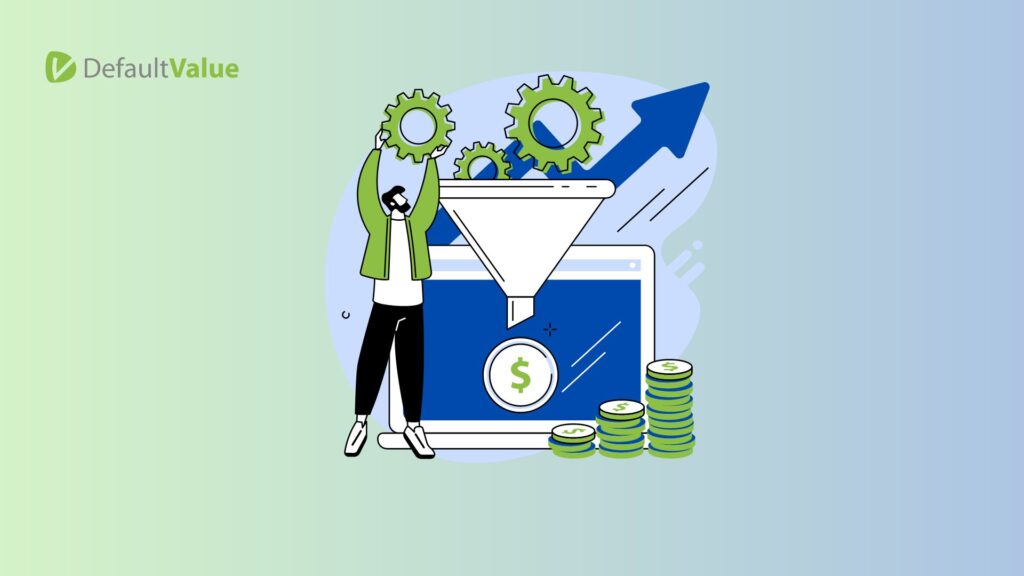How To Increase Ecommerce Conversion Rates
Conversion rate optimization provides an ideal opportunity to convert existing web traffic into paying customers. This process aims to convert your website visitors into leads and then customers.
In recent surveys, ~75 percent of companies reported having difficulty finding experts who can qualitatively optimize an eCommerce project to increase the eCommerce conversion rate.
We at Default Value have been developing Magento-based online store sites for over 13 years, and we can say with confidence: we’ve nailed online store optimization. And in this article, we’ll tell you in detail what exactly we’ve learned about conversion rates and methods for increasing them over the years. Let’s begin!
Understanding Ecommerce Conversion Rates
Conversion Rate is the ratio of users who have taken a targeted action on the site to the total number of visitors. This indicator is used to evaluate the effectiveness of advertising.
Calculating B2B eCommerce conversion rates is necessary at every stage of business activities. It is determined when drawing up a business plan as well as when planning a marketing campaign. This takes into account the accounting data available. These statistics allow for correcting critical indicators in time.
Typically, the level of conversion is defined for such targeting actions:
- from ad impressions—to clicks on ads (visits to the site);
- from site visits—to register or subscribe to a mailing list by email;
- from visits to the site—in the registration of the request for a callback;
- from visiting the site—to view the catalog of products;
- from browsing the catalog—to add goods to the cart;
- from visits to the website—to make a request or order;
- from viewing the article—to subscribe to the regular newsletter;
- from viewing the article—to users’ actions on social networks: likes, reposts, and comments.
It is the completion of the targeted action that is important in calculating the conversion rate. The user who committed the targeted action is called a lead.
For example, at the top level of the advertising funnel, consider the conversion from displaying ads into conversions to the site. Your ads were seen by 1200 users, of which 300 clicked through to the site. The conversion rate was 25%.

How is the Conversion Rate Calculated?
To calculate the typical eCommerce conversion rates, you need to know the conversion rate itself, an indicator of how users interact with the ad (click on a link, make a call, place an order, make a purchase). The coefficient is determined by dividing the number of conversions by the total number of interactions with site visitors. For example, 1,000 people visited an online site in a day, of which 100 people made the conversion. Therefore, the conversion rate ratio will be 10% (100/1000).

CR rate needs to be controlled by online stores and commercial and non-commercial sites. It allows you to monitor sales and keep track of the target audience. With its help, you can improve the site’s effectiveness and “efficiency.”
In the case of non-commercial online sites, the conversion factor allows you to monitor the number of registered visitors who subscribe to newsletters, download proposed files, leave comments, and test the site’s capabilities. To increase this figure, it is necessary to improve the site’s functionality, stay competitive, and raise the quality of the audience.
What is a Good Ecommerce Conversion Rate?
Typical eCommerce conversion rates vary by environment and industry—everything is different. That is, you cannot say that 5% is good or bad for your type of business. You have to determine this parameter based on your own historical and current data and take into account the current stage of business development and the channels used to promote the product. We recommend exchanging experiences with executives from similar businesses to understand benchmarks in your industry.
For example, if the sales figures from social networks are lower than those from search results (and this is usually the case), it does not mean that there is no need to advertise on them. After all, in social networks, users see your ads based on interest, and the algorithm in the search engines is different.
And you must recognize such a concept as seasonality of demand.

However, even CR is not the final truth. It’s also worth counting CAC (customer acquisition cost) and margin from each channel because the conversion to purchase may be lower from some channels, but the margin is higher.
There is such a thing as an average conversion rate—you compare the numbers for each attraction channel in one business and calculate the arithmetic average.
However, to determine whether the conversion rate is normal for you or not, you can use the ROI, which ideally should be above 100%.
ROI = (Income – Expenses) / Expenses * 100%
For example, you spent 1500 USD on advertising on social networks and received income from it 2500 USD. Then your ROI would look like this:
(2500 – 1500) / 1500 * 100% = 66%
What does conversion have to do with it? It shows the revenue—if your ad was effective, the user walked confidently down the funnel and eventually brought you profit, then the ROI will be high. In this case, the higher the number, the stronger and more profitable the business.
Additional Metrics to Help Measure Ecommerce Conversions
In addition to all of the above, there are several other things that are important to consider when evaluating the conversion rate.
Time
When calculating the conversion rate, we are particularly interested in the time we can measure the company’s success. For example, if your store has few visitors in a month, you need to collect data for at least six months to get a real picture.
Number of Visitors
Let’s assume CR came out at 100%. This is a signal that something went wrong-we probably took one visitor as an example. A large sample is needed to get the actual size of the ROI.
Average Order Value (AOV)
Average Order Value is one of the most important metrics for an online store because it clearly shows a business how much they can spend without compromising themselves to get a customer on favorable terms.
Abandoned Carts
One of the significant headaches of eCommerce projects is that a visitor adds a product to the cart but then closes the site without buying anything. According to research, the average abandonment rate for completing an online purchase is 69.80%. That percentage should be tracked so that you can adjust your strategy or site design in time.
Sales by Referrer
It’s important for retail projects to understand not only the source of traffic but also to keep track of sales by the referrer.
Return on Ad Spend (ROAS)
ROAS (Return On Ad Spend) is a ratio that shows whether or not advertising costs will pay off. With ROAS, you can calculate how much money each dollar invested in promoting products and services makes. And also – to estimate which advertising campaign is the most profitable.
ROAS differs from ROI in that its calculation does not take into account the cost of business to maintain the warehouse, payroll, office rent, and so on. Only advertising costs are taken into account.
With the ROAS calculation, the effectiveness of advertising is judged by reach and clicks. However, clicks and coverage do not show sales results. Sometimes people click on ads out of boredom or by mistake, not because they are ready to buy.
ROAS is what allows you to assess whether an ad campaign is paying off or not because it is directly related to revenue and costs.

10 Ways to Boost Your Ecommerce Conversion Rates
As we’ve said before, increasing conversions make a business more profitable, sustainable, and stronger. Here are a few ways to do this effectively.
- Build a process for analyzing and testing changes in campaigns. Examine the causes of low conversions (analyze the campaign, website, and customer experience), then look for ways to eliminate them. To do this, gather analytics and formulate hypotheses.
- Outline the user journey and marketing funnel. For example, in Miro, to understand what the stages are and capture who and how (projects, teams, channels) are influenced by them.
- Conduct qualitative in-depth interviews with users. This way, you can confirm your hypotheses and find new ones.
- Use end-to-end analytics systems. You’ll see the entire customer journey from ad click to purchase and track metrics across the entire sales funnel.
- Repackage the product using the Jobs-to-be-Done method. See how you can present its values and benefits to the customer in a new way across all communication platforms: website, newsletters, and social media.
- Check the site for usability. How comfortable is it for the user to perform the target action? Pay attention to the loading speed of the site. Test whether the site is easy to use from the mobile version and has clear navigation. Assess whether it’s easy to find all the information about the product and the buying process.
- Conduct an audit of the sales department. Find out how the department processes requests, what customers ask, and how and with which channels it works.
- Optimize advertising campaigns. Try new leads and creative calls to action that you get from in-depth interviews with audiences, and experiment with campaign goals.
- Personalize the site and ads so that the user sees exactly what they are interested in. For example, if you have an online store, use dynamic remarketing to offer products that the user has already personally viewed.
- Master new advertising platforms that you haven’t used before. If you’re only using targeting and context right now, try checking out TikTok or YouTube.
Final Word
Even after extensive market research, you may need to know your audience a little better.
Before you can build the perfect strategy and optimize the user experience on your site, you’ll have to run a lot of tests and put everything from images and text to the number of stages of completing a purchase to the test.
But that’s what conversion optimization is all about.
By studying your site from head to toe and evaluating every component of it to see how well it resonates with the needs and characteristics of your audience, you can improve eCommerce conversion rates, increase sales, and increase revenue and ROI.
That’s what conversion rate calculations are worth doing. Well, we at Default Value are happy to help you optimize your site for the needs of your audience. Submit a request through the feedback form, and we’ll rush to assist you!




